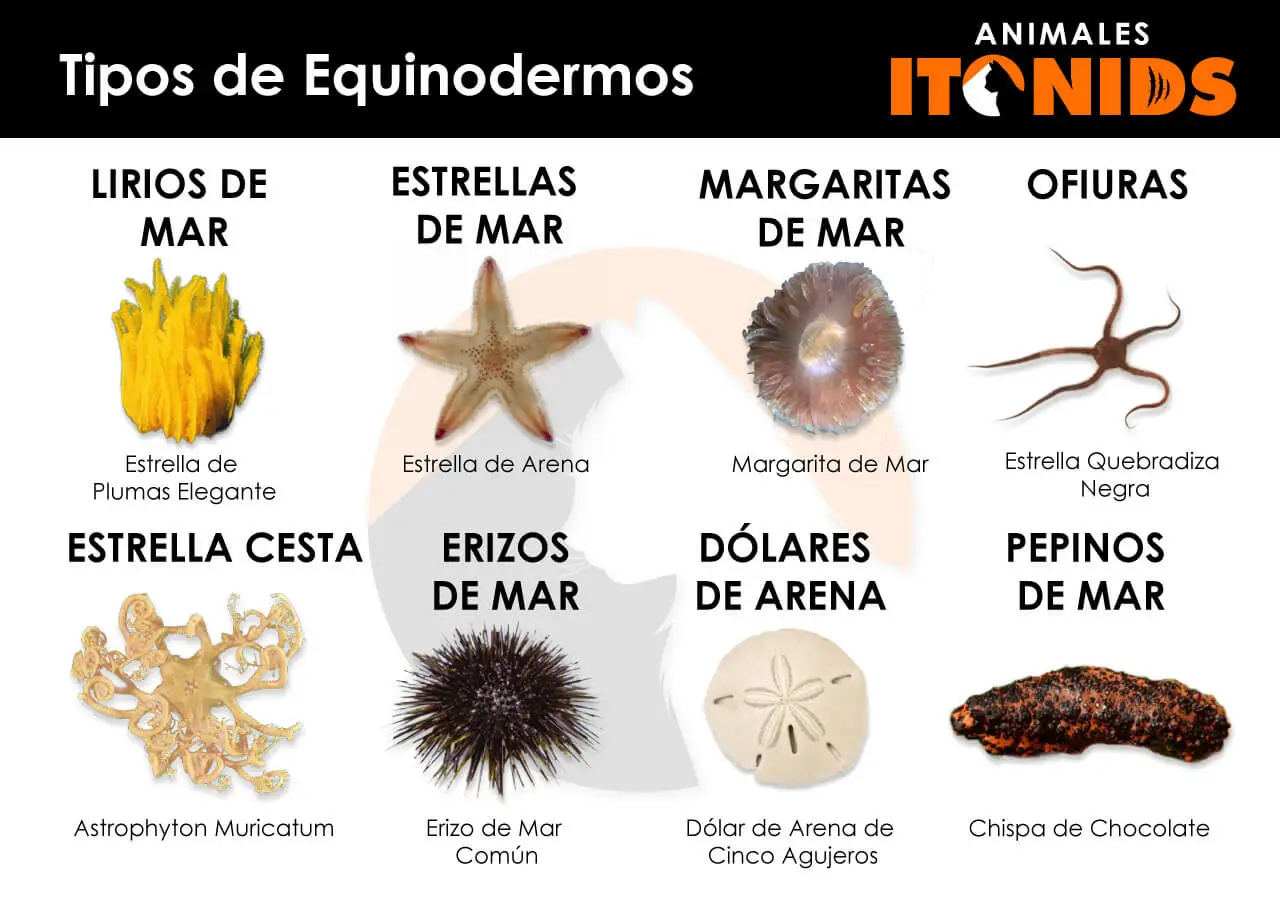From childhood, when asked to draw a marine landscape, we almost always include “starfish,” a symbol of marine life that is part of a fantastic and ancient group of animals known as “echinoderms.”
The name echinoderm, from the Greek “ekhinos” meaning spine, and “derma” meaning skin, translates to spiny or rough skin, a characteristic present in most species of the group.
Starfish, sea urchins, sand dollars, sea cucumbers… these are just some of the more than 7,000 species of echinoderms that currently exist! They can be found from the seashore to great depths.
Variable shapes and sizes, bright colors, a unique movement system (tube feet), and even poisonous spines, are some of the characteristics of echinoderms that awaken admiration and make them extraordinary beings of nature.
Learn all about echinoderms and discover interesting facts that will amaze you!
What are Echinoderms?
Echinoderms are a diverse group of marine invertebrates (animals without a backbone), which includes common animals like starfish and sea urchins, along with lesser-known forms (sea lilies, brittle stars, sea cucumbers, sand dollars…).
They have existed since ancient times, dominating the seas of our planet for more than 500 million years (Paleozoic era)! With about 20,000 species, they largely disappeared due to a process called glaciation (the Earth’s climate became very cold).
Currently, there are about 7,300 living species of echinoderms, and they belong to the rich and varied community of marine organisms that live in close relationship with the seabed (called benthos), commonly buried in the sand.
Did you know that…? An indigenous myth says that “the starfish” was the gods’ first attempt to create man, but not liking the result, they threw it into the sea and continued with a new creation, and there it stayed forever…
Main Characteristics of Echinoderms
Echinoderms are characterized by three main features:
Pentaradial symmetry, meaning they follow a common shape pattern, where the body, in its adult stage, can be divided into five equal parts (rays) arranged around a central axis, without differentiating their head.
In some species, during their first developmental stage, they exhibit bilateral symmetry, meaning their body can be divided into two identical halves, and as they grow, they adopt pentaradial symmetry.
Presence of an internal skeleton (or endoskeleton) formed by calcite plates (calcium mineral), called ossicles, which are located in the dermis (inner skin layer), fitting together or joined as a rigid skeletal shell (hard to bend).
Generally, this skeleton is covered with spines that project outward, capable of moving in all directions, giving their body surface the characteristic spiny appearance.
A unique system called the “water vascular system,” consisting of a network of hollow tubes called “tube feet” that end in suction cups (organ for gripping), and protrude from the body through a porous plate called “madreporite.”
Initially, these feet served the function of collecting and transporting food; later, they developed a locomotor function (movement), and are involved in most functions (respiratory, waste elimination…) by circulating seawater through them.
Some classes of echinoderms (Asteroidea and Echinoidea) have their bodies covered by small pincers or “pedicellariae,” useful for body cleaning (like the windshield wiper of a car), protection, and capturing prey.

Other Characteristics
- Different Body Shapes: star-shaped (starfish and brittle stars), globular (urchins), elongated (sea cucumbers), or branched (sea lilies).
- Variable Size (between 1 and 10 centimeters).
- Vibrant and diverse colors, thanks to pigment cells (which give color) in the epidermis (outer skin layer).
- Some species (crown-of-thorns starfish and fire urchin) have venom-loaded cells in their spines, causing pain and irritation.
- They have an internal fluid-filled space (coelom) whose walls are covered with cilia (small hairs), responsible for moving the fluid throughout the body.
- They possess simple and small eyes (ocelli) that do not provide detailed images but can perceive different degrees of light.
- The mouth is located on the lower and central part of the body (oral surface), and the anus on the dorsal part (aboral surface).
- They exhibit coordinated movements.
- They lack organs to control the internal pressure of their body (osmotic regulation), making it impossible for them to live outside of saltwater.
- Incredible regeneration ability (to rebuild their damaged or lost parts by themselves) and from severed arms or fragments, they can completely rebuild their body! Generally, the regeneration process is slow (it can take up to a year or more).
Did you know that…? The largest known echinoderm to date is the “Sunflower Star,” measuring over 90 cm wide, and is packed with 15,000 tube feet, also making it the fastest of its kind (about 70 centimeters per minute).
Nervous System
The nervous system is primitive, echinoderms do not have a brain, therefore, they act by reflex, captured through a network of sensory cells distributed around the mouth, the tube feet (network of small tubes protruding from their body), and their skin.
Circulatory System
The circulatory system is simple, open; echinoderms do not have a heart or blood; a liquid similar to seawater (called hemolymph) circulates through their body by a network that transports nutrients and facilitates waste elimination and the respiratory process.
Excretory System
They do not have an excretory system (wastes); therefore, echinoderms eliminate waste from their body through the tube feet (small external tubes).
Digestive System
The digestive system is simple, consisting of a mouth, esophagus, stomach, intestine, and ending in the anus (the latter may be absent in certain species).
Reproductive System
They have separate sexes, that is, female and male (dioecious), with their gametes or reproductive cells (eggs and sperm), located between the rays (arms), although there are hermaphroditic species (producing both gametes).
These reproductive cells are released externally through very small holes (gonopores) that act as ducts and open to the outside at the time of sexual reproduction.
Muscular System
Comprised of layers of circular and longitudinal muscles, located beneath the dermis and related to the bending of the arms, and the opening and closing of ducts.
Respiratory System
The respiratory system of echinoderms varies depending on the species, consisting of tube feet (tubes protruding to the exterior), gills (small lamina with holes near the mouth), papulae (holes on the body surface)… which facilitate the absorption of oxygen.
How Do Echinoderms Breathe?
Echinoderms breathe through external extensions (tube feet, papulae, gills, etc.) and the walls of their body (cutaneous respiration), thanks to a process called diffusion.
Seawater enters the echinoderm’s body, and the oxygen in it is captured, usually through their tube feet (small tubes that protrude outward) and other extensions:
- Asteroidea (starfish) use structures called “dermal papulae or gills,” which are small, soft spots on the skin.
- Ophiuroidea (brittle stars and basket stars) have folds known as “respiratory bursae.”
- Echinoidea (sea urchins) have external organs for gas exchange or “gills,” in communication with the digestive tube, moving water through it.
- Holothuroidea (sea cucumbers) have “respiratory trees,” a structure through which water is pumped and gas exchange occurs.
Once seawater enters the body, gas exchange occurs through diffusion, where oxygen in the water is absorbed and waste products are released, flowing into the water to be expelled.
How Do Echinoderms Reproduce?
The reproduction of most echinoderms is sexual and takes place at the beginning of summer.
During this time, groups of males and females gather in the sea to stimulate each other (by intertwining their arms) and release eggs and sperm into the environment, where fertilization occurs, either directly or indirectly.
In direct fertilization, the new individual develops directly from the eggs; in indirect fertilization (the most common), the egg goes through a series of stages that give rise to a larva and then transform into an adult through metamorphosis.
Others reproduce asexually, typically through fission, i.e., part of the body divides to give life to a new organism. Some species (starfish) are hermaphroditic (having both sexes).
The development of the embryo (egg) is “deuterostome, from the Greek ‘deuteros,’ meaning ‘second’ and ‘stoma,’ meaning ‘mouth,'” indicating that their mouth forms secondarily (after the anus).
Did you know that…? The sand star (Archaster typicus) stimulates in pairs; the male positions itself on top of the female, and they intertwine their arms to such an extent that they appear as a single ten-pointed star, staying together for one or more days, until they release their gametes.
What Do Echinoderms Eat?
Diet varies by species; they behave as carnivores (starfish), with a diet rich in bivalves, crustaceans, dead fish, and even other starfish, or herbivores (urchins, sea lilies) consuming algae and plankton.
Others (sea cucumbers) are detritivores, meaning they feed on organic matter using their highly branched tentacles, sweeping the seafloor or suspended material in the water.
Did you know that…? Starfish have an incredible ability; if they capture prey too large, they opt to protrude their stomach outside their body, through their mouth, and after all the prey’s tissue has been digested, they retract their stomach and move away.
Habitat
Echinoderms are marine; they abound on the coast but can extend to depths of thousands of meters (7000 meters), with tropical and subtropical marine waters being beneficial for their development and life forms; however, it is possible to find species in polar regions.
Some species live fixed to the seafloor, thanks to a peduncle or stem (sea lilies), others can move freely and slowly through the water (starfish and sea urchins), and some live semi-buried in the sandy and muddy bottom (mud), like Holothuroidea.
To a lesser extent, it is possible that some species (sea cucumber) have adapted to live in brackish waters (estuaries, caves…)
There are no parasitic forms among them.
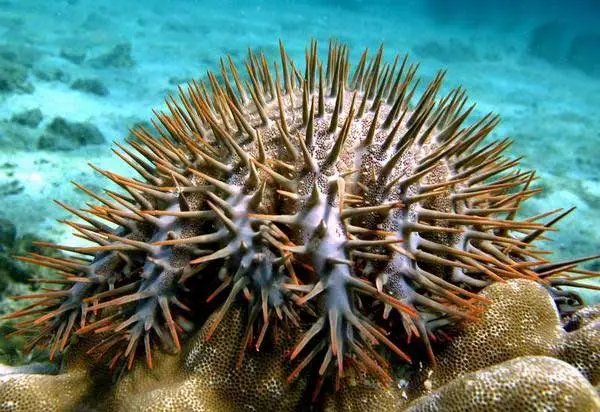
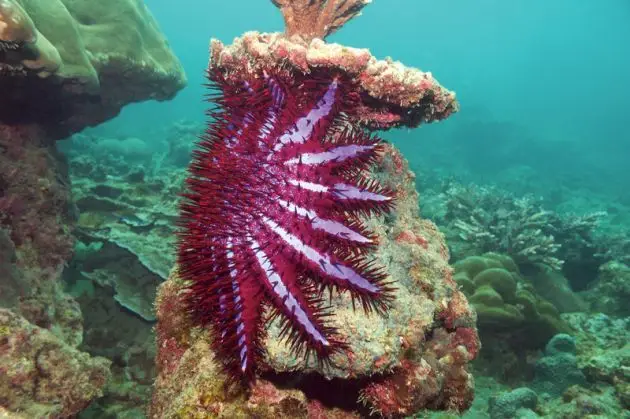

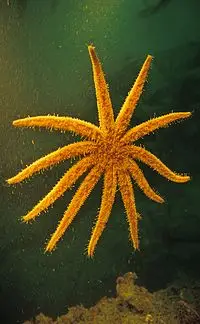
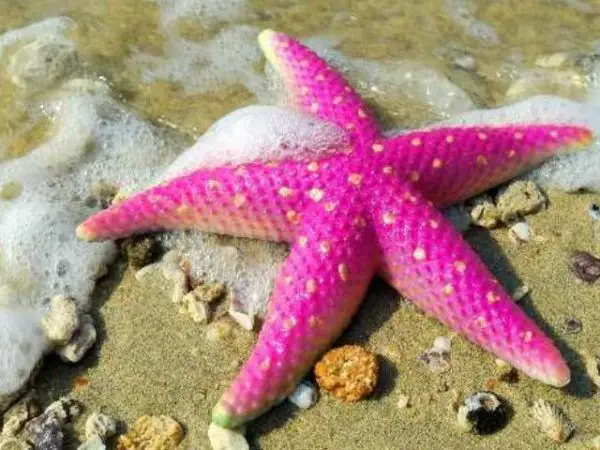

Echinoderm Classification
The Phylum “Echinodermata (Echinoderms)” is subdivided into two subphyla (subgroups) called Pelmatozoa and Eleutherozoa, grouping the species into six current classes.
- Class Crinoidea (Sea Lilies).
- Class Asteroidea (Starfish).
- Class Ophiuroidea (Brittle Stars and Basket Stars).
- Class Echinoidea (Sea Urchins and Sand Dollars).
- Class Holothuroidea (Sea Cucumbers).
- Class Concentricycloidea (Sea Daisies).
Subphylum Pelmatozoa (Pelmatozoans)
These are the immobile echinoderms, that is, they live fixed to the substrate, and includes the crinoids, cystoids, blastoids, and edrioasteroids (the last three classes are extinct).
Class Crinoidea (Crinoids)
The oldest class, with a cup or calyx-shaped body and about 625 representative species (Sea Lilies).
Subphylum Eleutherozoa (Eleutherozoans)
These are the mobile echinoderms and include five classes: asteroidea, ophiuroidea, echinoidea, holothuroidea, and concentricycloidea.
Class Asteroidea (Asteroideans)
Well-known, with a star-shaped body consisting of five or more arms and 1500 current species (Starfish).
Class Ophiuroidea (Ophiuroids)
Species with small, flat bodies, formed by five articulated arms, long and branched or not, with about 2000 species (Brittle Stars and Basket Stars).
Class Echinoidea (Echinoideans)
Globular or disc-shaped body, with skeletal plates forming a rigid shell (Sea Urchins, Sand Dollars).
Class Holothuroidea (Holothuroids)
Soft, cylindrical, elongated body, with about 1150 current species (Sea Cucumbers).
Class Concentricycloidea (Concentricycloids)
Echinoderms recently discovered, characteristic of deep waters (Sea Daisies). Some authors classify this species as a modified asteroidea.
Did you know that…? An international team of marine biologists discovered in 2011 a chilling species of echinoderm called “Ophiojura exbodi” in the depths of the South Pacific, which has remained virtually unchanged for 180 million years!
It is a unique case in the marine world and belongs to the class Ophiuroidea, with eight long arms (instead of the usual five) covered with rows of sharp spines.
Types of Echinoderms
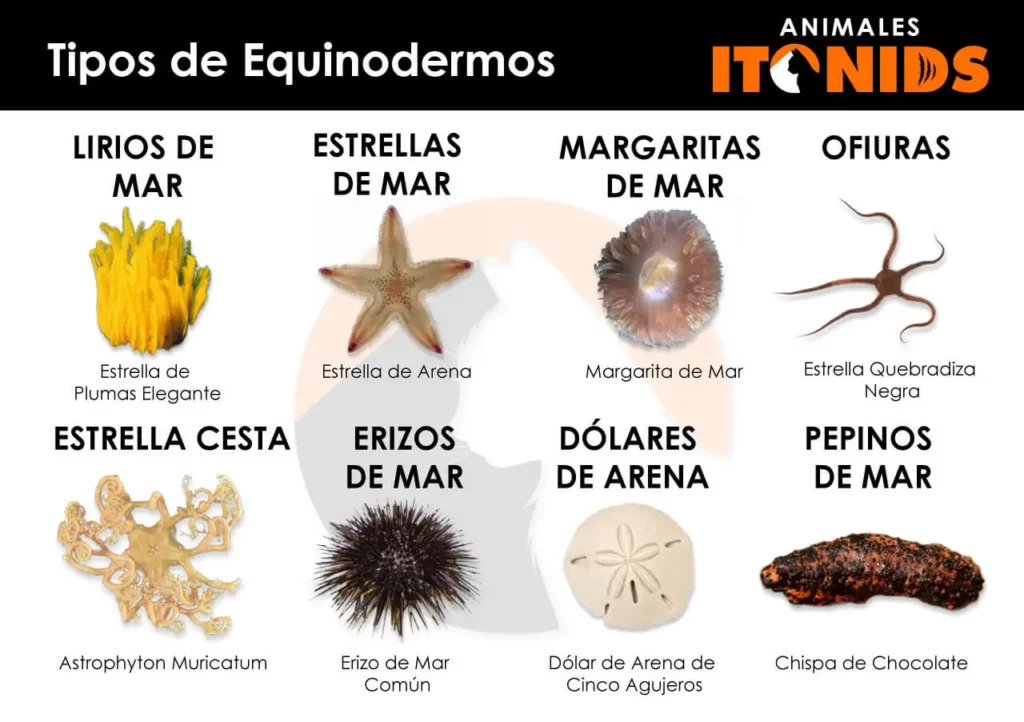
Sea Lilies
Also known as “feather stars,” with a cup-shaped body from which extend five long arms (which can split and become many more), they are immobile, and usually attached by a stalk (stem) to the sea floor.
Examples
Feather Star (Antedon mediterranea), Anneissia japónica, Davidaster rubiginosus, Elegant Feather Star (Tropiometra carinata)…
Starfish
A representative echinoderm, striking for its bright colors (red, orange, yellow…), its body is star-shaped with five arms (can be up to 50, as in the Antarctic starfish) covered in spines or tubercles, in some cases, toxic.
They are very common among rocks, in soft sandy or muddy bottoms, and in coral reefs in all the world’s oceans.
Examples
Common Starfish (Asterina gibbosa), Sand Star (Astropecten irregularis), Common Spiny Starfish (Marthasterias glacialis), Sunflower Star (Pycnopodia helianthoides)…
Sea Daisies
Discovered in the deep waters of New Zealand and the Bahamas, it includes three species, small in size (less than 1 centimeter in diameter), with a disc-shaped body, without arms, and associated with wood rich in bacteria.
Examples
Xyloplax medusiformis, Xyloplax janetae, Xyloplax turnerae.
Brittle Stars
They have a star-shaped body with five thin arms; they are fragile, highly mobile, and very abundant in all types of sea bottoms; they can swim and climb on algae.
Examples
Black Brittle Star (Ophiocomina nigra), Ophiolepis superba, Ophiojura exbodi, Amphiura arcystata…
Basket Stars
Their body is star-shaped with five highly extended arms full of spines and hooks, typical of cold seas (Arctic or Antarctica), found at great ocean depths.
Most of these curious stars belong to the genus “Gorgonocephalus, from the Greek “gorgós”, ‘terrifying’ and “cephalus”, ‘head’”, meaning, terrifying heads, imagine their appearance!
Examples
Gorgonocephalus stimpsoni, Astroboa granulatus, Euralyda habisal, Astrophyton muricatum…
Sea Urchins
They live on sandy bottoms, their body is semi-spherical, completely covered with movable spines of different sizes, with five hard pieces in their mouth, called “Aristotle’s lantern” similar to teeth.
Examples
Common Sea Urchin (Paracentrotus lividus), Large Sea Urchin (Echinus esculentus), Fire Urchin (Astropyga radiata), Heart Urchin (Abatus curvidens)…
Sand Dollars
Also known as “Sea Biscuits,” their name derives from their flat and oval shape, grayish in color, with a star shape in the center; they prefer to live in the sand and are found on beaches around the world.
Examples
Five-Hole Sand Dollar (Mellita quinquiesperforata), Eccentric Sand Dollar (Dendraster excentricus), Keyhole Sand Dollars (Mellita sp)…
Sea Cucumbers
Also called “Sea Cucumbers,” their body is cylindrical and elongated, cucumber-shaped, with tentacles (between 10 and 30), they are slow-moving animals, either moving slowly or attached to rock, and are known in all the seas of the world.
Examples
West Indian Sea Cucumber (Actinopyga agassizii), Holothuria cubana, Chocolate Chip Sea Cucumber (Isostichopus badionotus), Warty Sea Cucumber…
Importance of Echinoderms
Their high production of larvae serves as food for planktonic communities.
They are useful in scientific research (experimental embryology, pollution bioindicators, index fossils…)
Economically, the venom of some species (sea cucumber) is used by fishermen to create traps, and others (sea urchin, starfish) are used for medicinal purposes and as a dietary supplement, as their flesh is high in protein.
In other cases, certain species (starfish, sea urchins) are considered harmful as they invade oyster farms or coral reefs, creating an ecological imbalance during their feeding and reproduction.
Did you know? COTSbot is an artificial intelligence-equipped robot created in 2016 to patrol the Great Barrier Reef in Australia, in search of the crown-of-thorns starfish (abbreviated as COTS), to kill it with a lethal injection and thus curb its invasion.

